PPC Advertising Checklist to Increase Facebook Ads Conversions
Propelrr
February 23, 2023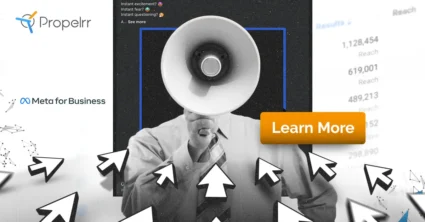
Don’t settle for sub-par pay-per-click (PPC) advertising efforts with Facebook Ads.
Are you having trouble getting conversions with your Facebook ads? Feel like you’re just throwing your budget away with each ad boost you do?
Then perhaps it’s time you picked up a few optimization tricks from an established PPC advertising company.
PPC advertising on Facebook – why is it so difficult?
Make sure to follow it to a T in your Facebook Ad optimizations and you can expect cost-effective results in no time.
Defining Facebook Ad optimization in PPC management
Facebook Ad Optimization is a set of actions to improve the performance of your Facebook Ad campaigns.
Brands use this strategy so they can post content to promote their products and services which helps widen their target audience, drive high-quality traffic to their website, and boost conversion rates for your business.
Why is Facebook Ad optimization important in PPC advertising?
Running your ads without any improvements and optimizations can cost a lot for your campaigns. What if your current setup isn’t working? Or, what if there are better ways and options to run your ads?
Don’t let those thoughts rain on your parade. That is why you should regularly do ad optimizations to test further and improve the effectiveness of your campaigns.
Facebook Ad Optimization can help target the right audience every time you run ads. It keeps your ads and campaigns at a cost-effective price. Plus, you can keep your audience from experiencing ad fatigue.
If you want to know what kind of optimizations you should be doing, here’s a quick guide to optimizing your Facebook Ads.
- Plot out your strategy.
- Translate data into ad insights.
- Track your conversions.
- Choose the right Facebook marketing objectives.
- Know your target audience.
- Layer targeting audience to pinpoint buying intent.
- Create Lookalike Audiences.
- Choose an Ad Format.
- Optimize your ad creatives.
- A/B test your iterations.
- Schedule your ads during optimal hours.
- Use Campaign Budget Automation.
- Maximize the Facebook Rules and Automation feature.
- Look beyond Facebook Ads.
Let’s jump into it.
1. Plot out your strategy.
Posting Facebook ads can be tricky. That’s why we need to know its importance for your campaign first before we dive into the checklist. This will help you create a solid Facebook ad campaign that you can further optimize with the checklist.
-
Objectives. To create a successful Facebook ad, you need to know what your objectives are. You need to be precise when it comes to thinking of a target. It’s easy to label interactions simply as “conversions”. But in truth, there are many types of conversions for Facebook Ads.
These include lead generation in the form of sign-ups or sales. Luckily, Facebook gives you a clear description of each type of conversion as you setup your goals. That, we’ll discuss in more detail later on.
-
Brand maturity and marketing priorities. Is my business a start-up or a household name already? Honestly answering this will help you set key performance indicators (KPIs) and the priorities of creating a Facebook advert. It will also decide on the budget, target audience, and overall strategy of your Facebook ad.
-
Target audience. Where do you want to capture your audience or potential customers after clicking your ad? Are you going to use a landing page or an app? Does your digital infrastructure have tracking codes in place? Does your app have deep links?
Having a well-built digital infrastructure will not just help you have a higher chance of getting potential customers, but also receive important data that will help you get an idea of how you can optimize Facebook Ads in the future.
- Mobile and desktop ads. If you’re wondering what better platform between mobile and desktop works best for ads, the answer is both. Both have their own strengths that you can use to your advantage.
Ads for desktop allows you to use ads with two different placements; the desktop news feed and the right-hand sidebar. The newsfeed is the bread and butter of Facebook advertising. Meanwhile, the sidebar is pretty much used for awareness campaigns.Meanwhile, mobile gives you access to the mobile news feed and Facebook’s “instant article” placement. The instant article is a mobile-optimized feature that allows businesses to post fast-loading interactive articles to the Facebook app.
-
Infrastructure. Where do you want to capture your audience or potential customers after clicking your ad? Are you going to use a landing page or an app? Does your digital infrastructure have tracking codes in place? Does your app have deep links?
Having a well-built digital infrastructure will not just help you have a higher chance of getting potential customers, but also receive important data that will help you get an idea on how to optimize Facebook Ads in the future.
-
Current analytics data. How do you find out if your Facebook ad is successful? Obviously, through your KPIs such as cost-per-conversion (CPA), click-through-rate (CTR), average order value (AOV), and customer lifetime value (CLV).
Study previous data on your Facebook ads manager, regardless if it’s for organic or boosted posts. This can be your starting point when setting targets for your ads. Later on, data from your previous tests and ads can be used to create higher-converting Facebook Ads.
2. Translate your data into ad insights.
-
Track your conversions. What exactly is a conversion? A conversion is an action a person takes on your page or website. It can be anything from registration, adding an item to the shopping cart, or simply viewing a particular page.
Conversion tracking, on the other hand, is one way for you to follow the movements of the people engaging with your page or website. This can be done using Facebook Pixel to track your visitor’s actions. With a few lines of code from Facebook and standard events, you can track the activities of your website’s visitors.
Alternatively, you can create custom conversions based on the Facebook Ads guidelines in the events manager. You can use this to define further visitor actions that should be tracked.
-
Choose the right Facebook marketing objectives.
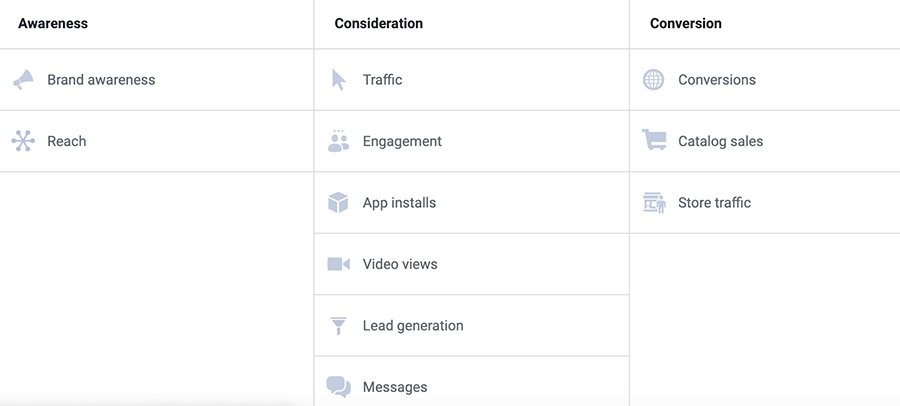
Facebook has three marketing objectives to help social media marketers steer their campaigns in a general direction. Choose the right one according to the needs of your business/digital marketing campaign.
- Awareness
Nobody paying attention to your business? Maybe you don’t have a strong following yet, or perhaps your business is still new. You can create ads to generate interest, reach, and awareness about your product/service. It’s telling people what you or your product can offer.
-
-
Reach. This refers to the total number of people aware of a certain medium or platform.
-
- Awareness
-
- Brand Awareness. This is the extent to which an audience knows your products and services.
This is one way to get people to seek more information about your business. Usually, this type of advertising objective creates a campaign that will encourage people to visit your website or page. Doing this will increase website traffic, engagement, app installs, video views, messages, and lead generation.- Traffic. Refers to web users who visit a website.
-
- Engagement. Refers to the public shares, likes, and comments for a certain business or contentApp Installs. Used to drive installs from sources outside of the app marketplaceVideo Views. Refers to how many times a video has been viewedLead Generation. the process of identifying potential buyers for a business’s product or service.
- Messages. Inquiry of potential customers and buyers to a business.
Conversions
This is the objective that gets people to purchase or use your product/service. Conversions campaigns will encourage people (your potential customers) to stop by the store, page, or website to purchase something. Conversions, catalog sales, and store traffic are expected to increase if done right.- Conversions. Occurs when a visitor to your website completes a desired goal like purchasing, signing up, etc.
-
- Catalog Sales. A sales technique used to group many products in one online store.Store
-
- Traffic. Refers to the number of people who visit a platform or online store.
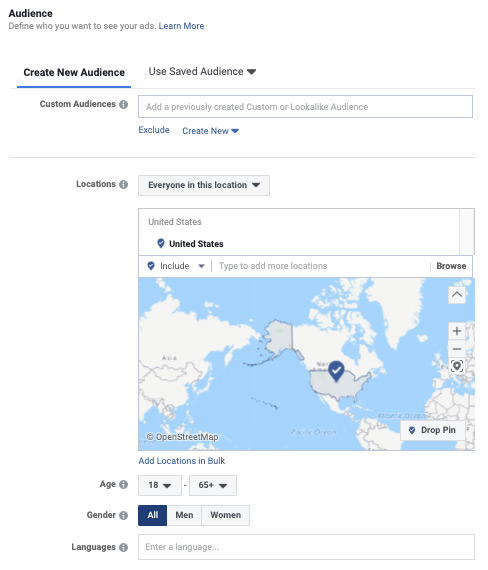
If you want to take things up a notch and be a little bit more specific, Facebook allows you to create custom audiences. You can manually upload a CSV file with the data you’ve gathered from a trade fair, email sign-ups, etc. Just make sure to read the Facebook advertising guidelines first.
Alternatively, websites with Facebook Pixel will allow you to retarget anyone who has visited your page.Here’s a list of ways you can do to get a target audience in Facebook Ads:
- Set your demographics.Target audience’s interest.Target buyer profiles.Target mobile phones.Find people who are already looking for your kind of product.
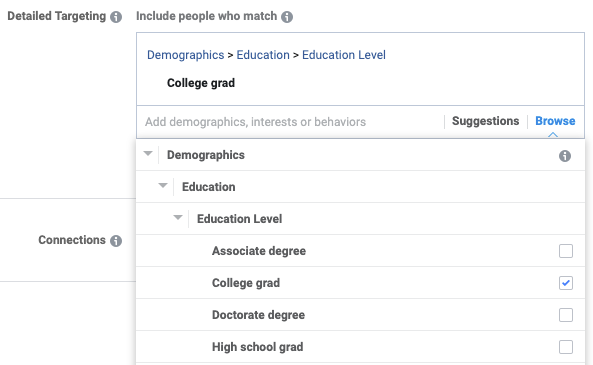
Apart from demographics and location, you can take your ad to another level by using layered targeting. This Facebook advertising tip goes well beyond the demographics.Using the social media platform’s ads manager tool, you can pinpoint buying intent by targeting education level, work status, financial income, home type, life events, and other buying behaviors.
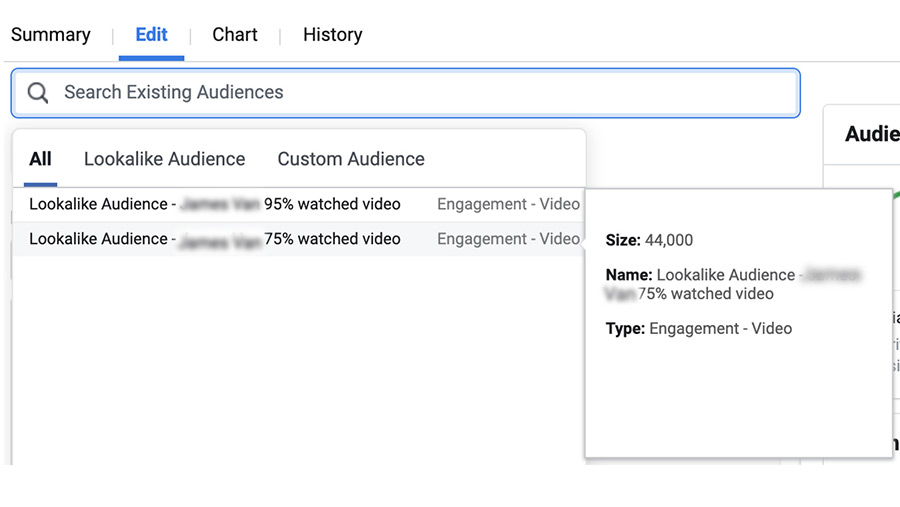
Facebook took its targeting capabilities one step further with a Lookalike Audience. No, it won’t search for people who look like you or any celebrity. This Facebook Ads optimization tool will search for new people who are most likely interested in your business based on the characteristics and qualities of a previous custom audience.
It does this by identifying the common qualities of the people targeted in your previous ad campaigns. Facebook then searches for similar profiles to create a larger audience and potential reach; hence the term lookalike.
Choose an Ad format.Posting ads on Facebook is more than simply uploading an image/video and waiting for the pay-per-click algorithm to kick in. Marketers need to put more thought into the overall user experience with the right ad format for optimal reach and engagement.There are four major ad formats for Facebook that you need to know and maximize. Check out the ad sizes and other specs to create a Facebook ad campaign.
-
Image Ads. The most basic ad format. One way or the other, all ads on Facebook – regardless if it’s a video or not – need an image relevant to the product or service. Images can be used to increase brand awareness, engagement, reach, and even store traffic.
The recommended dimension for an image is 1200 x 628 pixels, with a minimum width and height of 600 pixels. The aspect ratio can be anything between 9:16 to 16:9. File sizes need to be jpeg or png format. Take note that images with 20 percent or more might not pass Facebook’s guidelines.
Video Ads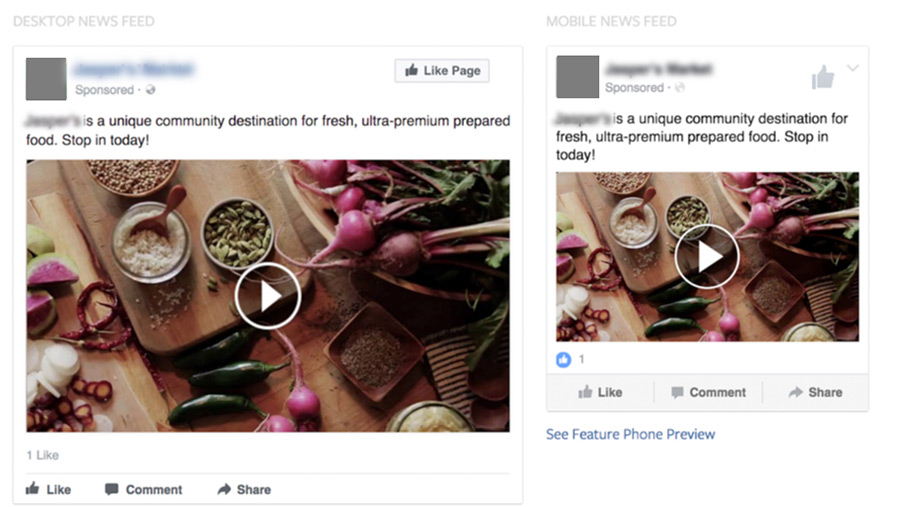
Did you know that a video generates 12 times the shares than texts and images combined? If you want to grow your brand’s reach, using video ads is a must. It’s a compelling format that can run on both Facebook and Instagram.
It’s recommended to upload the highest resolution possible. Make sure to tick “upload in HD” in the settings. The inimum dimension is 600 x 315 or 600 x 600. Like image ads, aspect ratio should play between 9:16 to 16:9 or 1:1. As for formats, MP4 or MOV are accepted for video ads with a maximum file size of 4GB and a length of 240 minutes.
-
Carousel
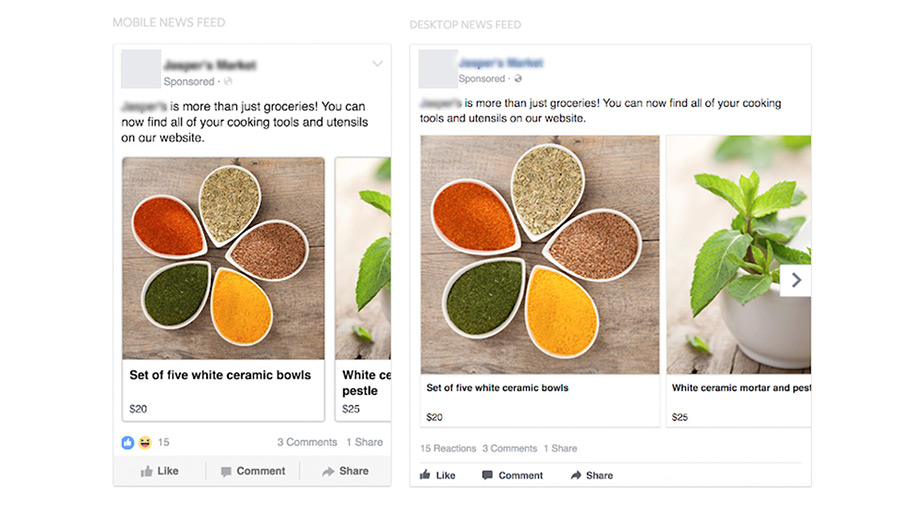
Carousel ads need to be 1080 x 1080 pixels in size for both photo and video. You can post a minimum of two “cards” and a maximum of ten.
It allows you to upload ten images/videos in a single ad. Another great feature for carousel ads is that each image/video can have its own link. This type of ad format will do wonders for various ad objectives, well, pretty much every single one.
You can go for a max image size of 30 MB, while videos can go up to 4GB. This type of ad works best with any mobile platform, thanks to the swipe function of gadgets today.
Do you have several products that you want to showcase? If so, this ad type will fit your campaign perfectly.
-
Instant Experience
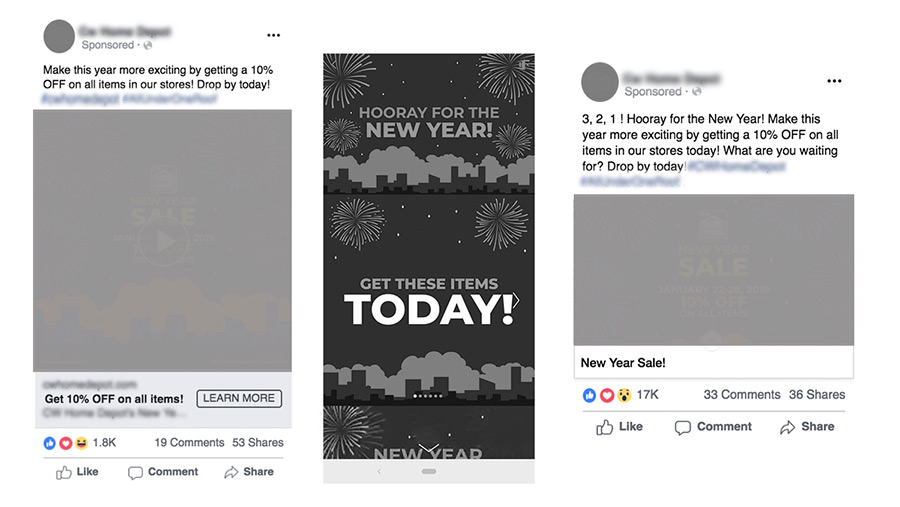
If that isn’t enough to increase your brand’s reach and engagement, Instant Experience ads should do the trick (if executed right, that is). It can mix carousels, images, videos, and other formats into one cohesive ad and is best deployed to iOS and Android users.
The same specifications and requirements for the images and videos stated above apply here as well.
Optimize your ad creatives.

The ad creative is an image/video that contains the visual attributes of an ad. We already know that the ad text shouldn’t take up to 20% of the photo. Aside from that, it’s suggested to have colorful ads when you advertise on Facebook to easily attract attention.
For better ads, you need to make sure that it has the “conversion trinity formula” – relevance, value, and a call-to-action. Don’t forget to include your main proposition in the image of the ad to make it easier for people to get an idea of what it’s about and spark curiosity.
Quick visual design best practices:
- Use influential images and graphics.
- Always have enough white space.
- Use colors in clever and creative ways.
- Practice consistency in design, fonts, etc.
- Break up the content into readable parts.
For more tips, check out our visual content best practices and learn more about it.

How do you know if an ad is working? Is there a way to optimize it for future campaigns? Of course, there is, and it’s called ads A/B testing or split testing. It’s essentially experimenting with two or more variants of an ad to find out which gets better results based on data received. There are several benefits that you can get from A/B testing. These include improved engagement, reduced bounce rates, increased conversions, and easier data analysis. With the results, you can adjust and alter your digital marketing strategy to bring in a better return on investment (ROI).
Another way to find out the best time is to try dayparting. It is the practice of running ads at a specific time and day. Based on your past data, you can extract the best time of the day you can run campaigns.

The fantastic thing about using Facebook is its automation. More specifically, the Facebook budget optimization, which allows you to create certain rules that automatically adjusts to your budget for an ad campaign.
Not enough time to manage all the ads you’re running? Facebook’s Rules and Automation help you manage multiple ads running at the same time.Like budget automation, this tool helps you pre-set rules based on KPIs such as likes, shares, lead generation, etc. When the conditions are met, Facebook will run your ads, effectively saving you time. It will, however, require a little effort on trial and error.
Now that you have a general direction for your ad objective, it’s time to translate all that into a strategy to start your ad. Take a look at these ad optimization techniques that you can apply to your own campaigns.
3. Look beyond Facebook Ads.
There are quite a few things that you can do to maximize conversions beyond this Facebook ad optimization checklist and the social media platform itself. Allow us to give you an idea of how to do that.
-
Optimizing your landing pages. Landing pages will play a huge part when it comes to conversion rates. After all, this is usually the place where you send your target audience to engage with your business/service. That’s why it’s important to optimize it.
There are many ways you can optimize your landing page to increase conversion rate optimization (CRO). There are options like making your offer clear, simplifying it, and using an effective call-to-action. CRO focuses on the ability of the landing page to convert visits into conversions. It’s an important metric that will help you see and decide on things that need to be improved upon or what to test out.
Key takeaways
A successful Facebook ad campaign does not only translate from having great content or engagement, but you should also look after your conversions and see what efforts worked best. Here are a few takeaways:
- Have a cohesive marketing objective. It does not only apply to Facebook but also in all aspects of taking care of your brand.
- Inspect your data often. This is also an effort in knowing your brand and the possibilities that you can solve in your campaigns.
- Take advantage of the straightforwardness. Thanks to Facebook’s clear and straightforward marketing objectives, this tool greatly contributes to your targeting and reach.
In case you’re still having trouble though, feel free to send us a message on Facebook, X, or LinkedIn, and we’ll take care of things for you.
For more PPC management and ad optimization tips, subscribe to our newsletter and we’ll deliver them straight to your inbox.